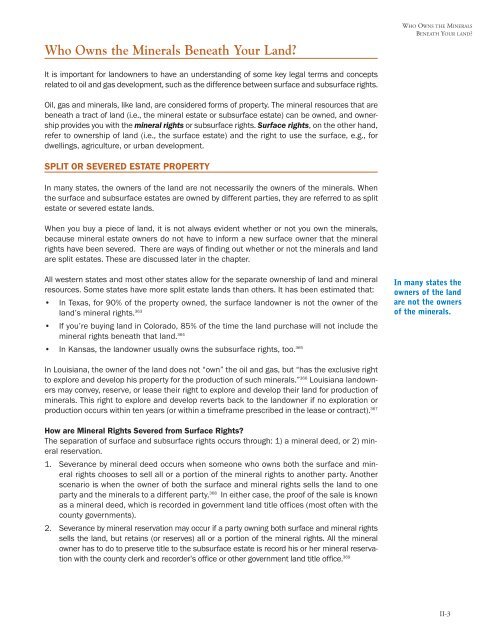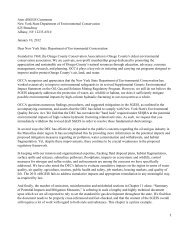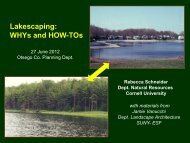Oil and Gas at Your Door? (2005 Edition) - Earthworks
Oil and Gas at Your Door? (2005 Edition) - Earthworks
Oil and Gas at Your Door? (2005 Edition) - Earthworks
Create successful ePaper yourself
Turn your PDF publications into a flip-book with our unique Google optimized e-Paper software.
Who Owns the Minerals Bene<strong>at</strong>h <strong>Your</strong> L<strong>and</strong>?<br />
WHO OWNS THE MINERALS<br />
BENEATH YOUR LAND?<br />
It is important for l<strong>and</strong>owners to have an underst<strong>and</strong>ing of some key legal terms <strong>and</strong> concepts<br />
rel<strong>at</strong>ed to oil <strong>and</strong> gas development, such as the difference between surface <strong>and</strong> subsurface rights.<br />
<strong>Oil</strong>, gas <strong>and</strong> minerals, like l<strong>and</strong>, are considered forms of property. The mineral resources th<strong>at</strong> are<br />
bene<strong>at</strong>h a tract of l<strong>and</strong> (i.e., the mineral est<strong>at</strong>e or subsurface est<strong>at</strong>e) can be owned, <strong>and</strong> ownership<br />
provides you with the mineral rights or subsurface rights. Surface rights, on the other h<strong>and</strong>,<br />
refer to ownership of l<strong>and</strong> (i.e., the surface est<strong>at</strong>e) <strong>and</strong> the right to use the surface, e.g., for<br />
dwellings, agriculture, or urban development.<br />
SPLIT OR SEVERED ESTATE PROPERTY<br />
In many st<strong>at</strong>es, the owners of the l<strong>and</strong> are not necessarily the owners of the minerals. When<br />
the surface <strong>and</strong> subsurface est<strong>at</strong>es are owned by different parties, they are referred to as split<br />
est<strong>at</strong>e or severed est<strong>at</strong>e l<strong>and</strong>s.<br />
When you buy a piece of l<strong>and</strong>, it is not always evident whether or not you own the minerals,<br />
because mineral est<strong>at</strong>e owners do not have to inform a new surface owner th<strong>at</strong> the mineral<br />
rights have been severed. There are ways of finding out whether or not the minerals <strong>and</strong> l<strong>and</strong><br />
are split est<strong>at</strong>es. These are discussed l<strong>at</strong>er in the chapter.<br />
All western st<strong>at</strong>es <strong>and</strong> most other st<strong>at</strong>es allow for the separ<strong>at</strong>e ownership of l<strong>and</strong> <strong>and</strong> mineral<br />
resources. Some st<strong>at</strong>es have more split est<strong>at</strong>e l<strong>and</strong>s than others. It has been estim<strong>at</strong>ed th<strong>at</strong>:<br />
• In Texas, for 90% of the property owned, the surface l<strong>and</strong>owner is not the owner of the<br />
l<strong>and</strong>’s mineral rights. 363<br />
• If you’re buying l<strong>and</strong> in Colorado, 85% of the time the l<strong>and</strong> purchase will not include the<br />
mineral rights bene<strong>at</strong>h th<strong>at</strong> l<strong>and</strong>. 364<br />
• In Kansas, the l<strong>and</strong>owner usually owns the subsurface rights, too. 365<br />
In many st<strong>at</strong>es the<br />
owners of the l<strong>and</strong><br />
are not the owners<br />
of the minerals.<br />
In Louisiana, the owner of the l<strong>and</strong> does not “own” the oil <strong>and</strong> gas, but “has the exclusive right<br />
to explore <strong>and</strong> develop his property for the production of such minerals.” 366 Louisiana l<strong>and</strong>owners<br />
may convey, reserve, or lease their right to explore <strong>and</strong> develop their l<strong>and</strong> for production of<br />
minerals. This right to explore <strong>and</strong> develop reverts back to the l<strong>and</strong>owner if no explor<strong>at</strong>ion or<br />
production occurs within ten years (or within a timeframe prescribed in the lease or contract). 367<br />
How are Mineral Rights Severed from Surface Rights?<br />
The separ<strong>at</strong>ion of surface <strong>and</strong> subsurface rights occurs through: 1) a mineral deed, or 2) mineral<br />
reserv<strong>at</strong>ion.<br />
1. Severance by mineral deed occurs when someone who owns both the surface <strong>and</strong> mineral<br />
rights chooses to sell all or a portion of the mineral rights to another party. Another<br />
scenario is when the owner of both the surface <strong>and</strong> mineral rights sells the l<strong>and</strong> to one<br />
party <strong>and</strong> the minerals to a different party. 368 In either case, the proof of the sale is known<br />
as a mineral deed, which is recorded in government l<strong>and</strong> title offices (most often with the<br />
county governments).<br />
2. Severance by mineral reserv<strong>at</strong>ion may occur if a party owning both surface <strong>and</strong> mineral rights<br />
sells the l<strong>and</strong>, but retains (or reserves) all or a portion of the mineral rights. All the mineral<br />
owner has to do to preserve title to the subsurface est<strong>at</strong>e is record his or her mineral reserv<strong>at</strong>ion<br />
with the county clerk <strong>and</strong> recorder’s office or other government l<strong>and</strong> title office. 369<br />
II-3




